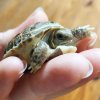Interesting observation. Outside, on hot summer days, when a cloud passes over, the adult and juvenile tortoises often come out and walk around, eat, drink, then go hide again when the cloud passes.
I decided to mirror the situation in my closed chamber baby habitat, where I have the basking lamp (but not the UV tube light) cycle off for 15 mins 2x during the afternoon (1 peg in my analog timer).
Sure enough. The babies come out of their humid hide and start walking around and eating. Every time.
That slight temporary drop in ambient temp might be important. What do you think?
Baby pic for cute tax.

I decided to mirror the situation in my closed chamber baby habitat, where I have the basking lamp (but not the UV tube light) cycle off for 15 mins 2x during the afternoon (1 peg in my analog timer).
Sure enough. The babies come out of their humid hide and start walking around and eating. Every time.
That slight temporary drop in ambient temp might be important. What do you think?
Baby pic for cute tax.
